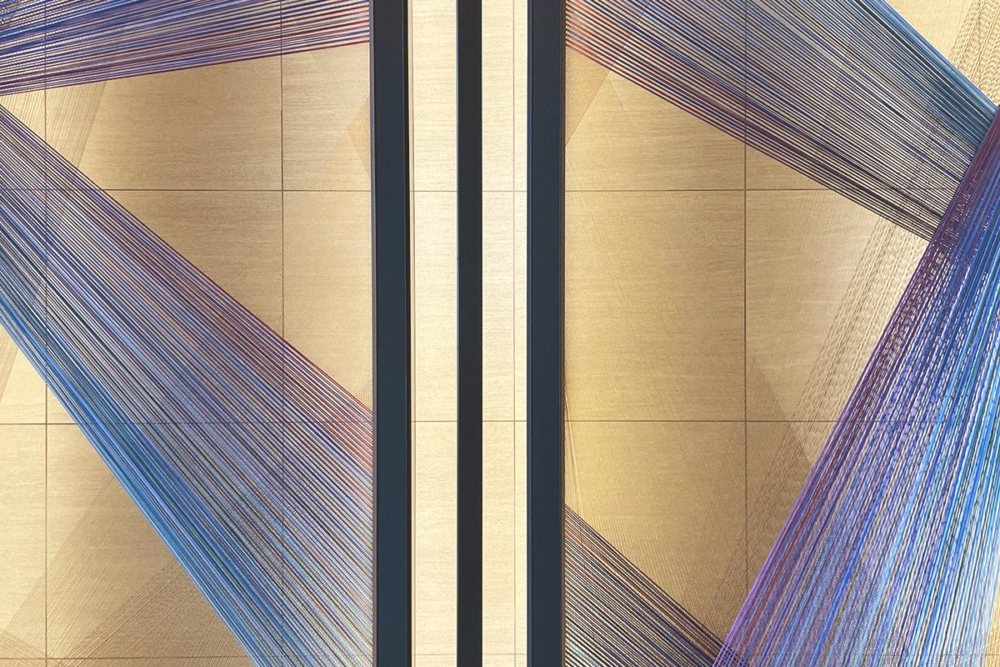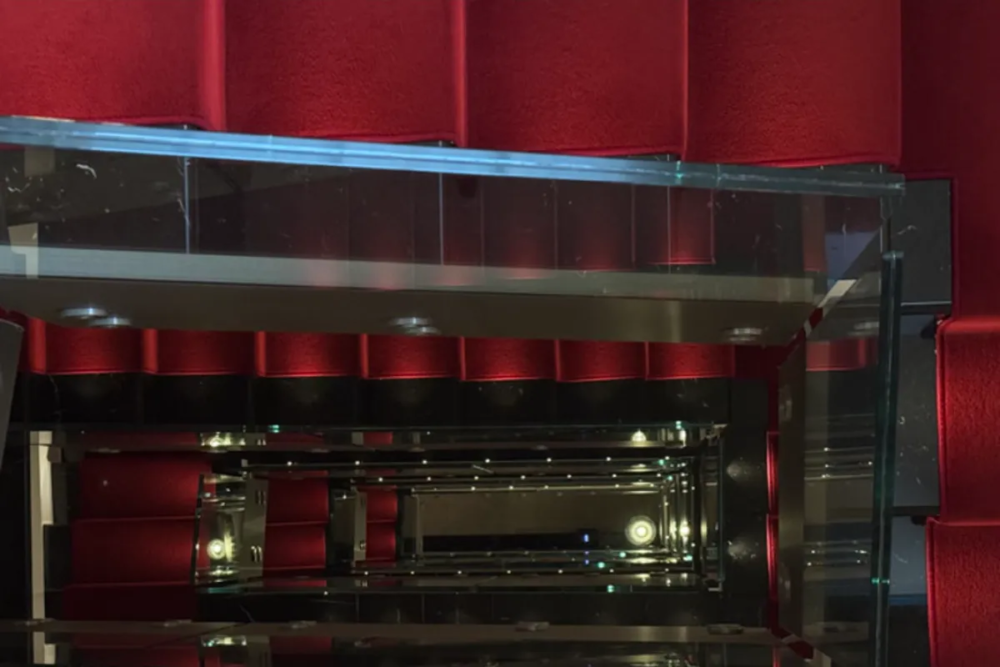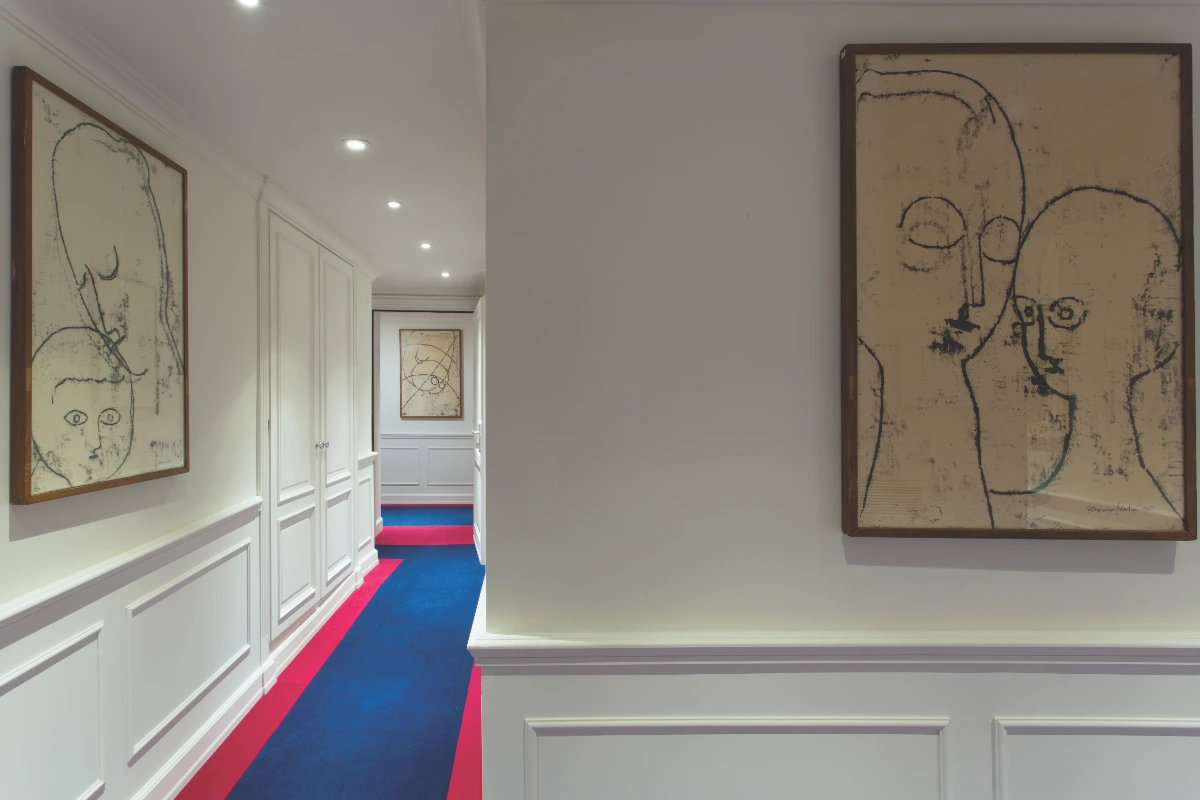
From Residence to Riverside Hotel: The Architectural Evolution of Hotel Lungarno
From Picasso and Cocteau to Tuscan gastronomy, Hotel Lungarno integrates cultural heritage and local craftsmanship into the contemporary experience of hospitality
The Hotel Lungarno: culture and hospitality along the Arno river
Since its opening in 1995, Hotel Lungarno has stood as the cornerstone of the Lungarno Collection, the luxury hospitality group founded by the Ferragamo family. Located along the Arno River, just a few meters from Florence’s Ponte Vecchio, Hotel Lungarno has shaped an identity where hospitality merges with the arts and the cultural life of the industry.
The building itself reflects the Renaissance heritage of the city: a former residential palace transformed into a hotel, maintaining its original proportions and relationship with the river. Its terraces and interiors offer direct views over the Ponte Vecchio and the Uffizi, embedding guests into the historical and cultural heart of Florence. Hotel Lungarno interprets hospitality as a cultural practice rooted in dialogue with the city’s artistic and architectural fabric.
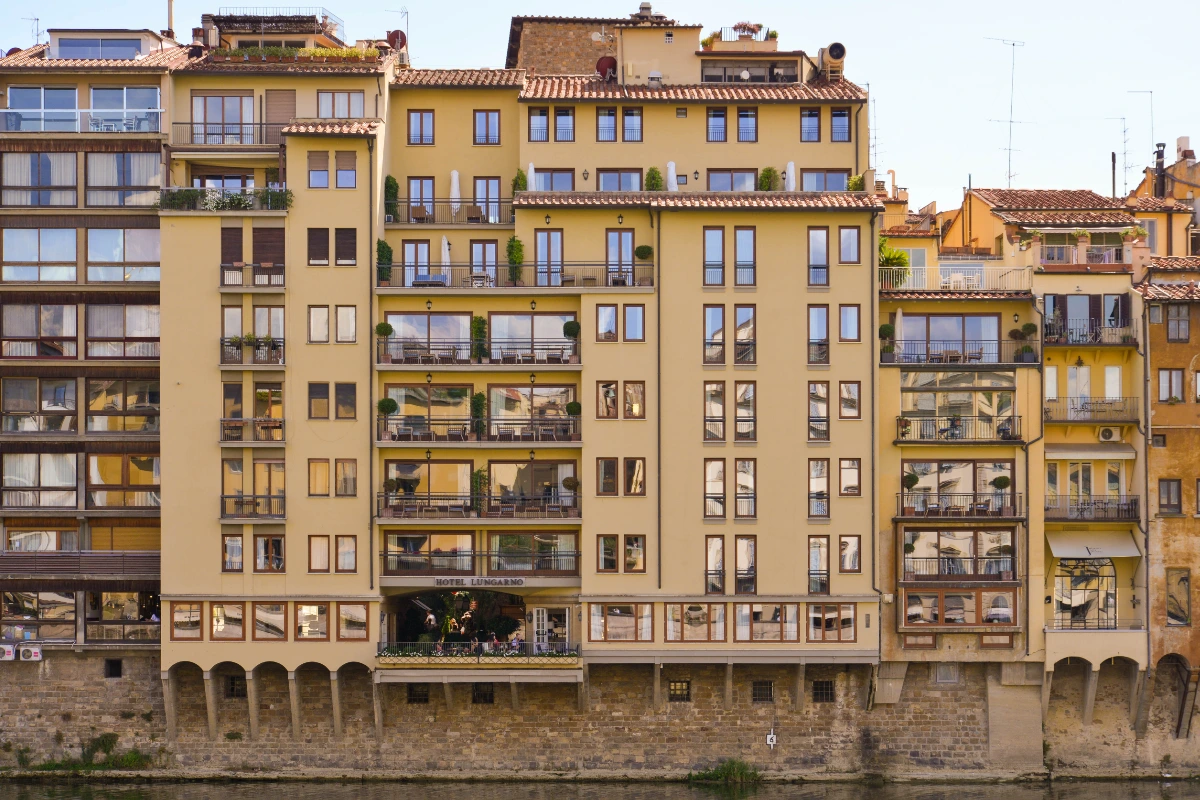
A Renaissance echo: architecture and history of the building
The site where Hotel Lungarno stands has long been a privileged vantage point along the river. The building itself dates back to the early twentieth century but draws inspiration from older Florentine palaces that lined the Arno for centuries. Its linear façade, punctuated by regular windows and modest ornamentation, wants to echo the sober elegance of Renaissance domestic architecture.
The original structure was designed as a private residence, typical of the urban development of the Oltrarno district during the post-unification period in Italy. Over time, the property underwent different transformations before being acquired in the 1990s by the Ferragamo family, who commissioned a renovation to adapt the building to its new hospitality function while preserving its historical character.
The 2017 refurbishment, led by Michele Bönan, maintains a balance between historical memory and contemporary functionality. Period architectural elements were preserved whenever possible, while new interventions were designed to integrate into the original structure, using local materials and traditional craftsmanship techniques.
The Oltrarno district: historical surroundings and contemporary life
The Oltrarno, the left bank of the Arno River, has historically been considered Florence’s artisan quarter. Unlike the more formal and monumental right bank, the Oltrarno has preserved a more residential and artisanal character. Narrow streets, hidden gardens, and historic workshops define the texture of the neighborhood, offering a different perspective on Florentine life.
The proximity to the Ponte Vecchio situates Hotel Lungarno inbetween the medieval core of the city and the quieter, lived-in atmosphere of the Oltrarno. This location allows guests access to major landmarks such as the Uffizi Gallery and Palazzo Pitti, while also immersing them in the daily rhythms of local life: from traditional botteghe to contemporary galleries, from family-owned trattorias to experimental art spaces.
This dual identity of the neighborhood – historic yet vibrant – mirrors the concept that underpins the Hotel Lungarno itself: a place where tradition and innovation coexist without friction.
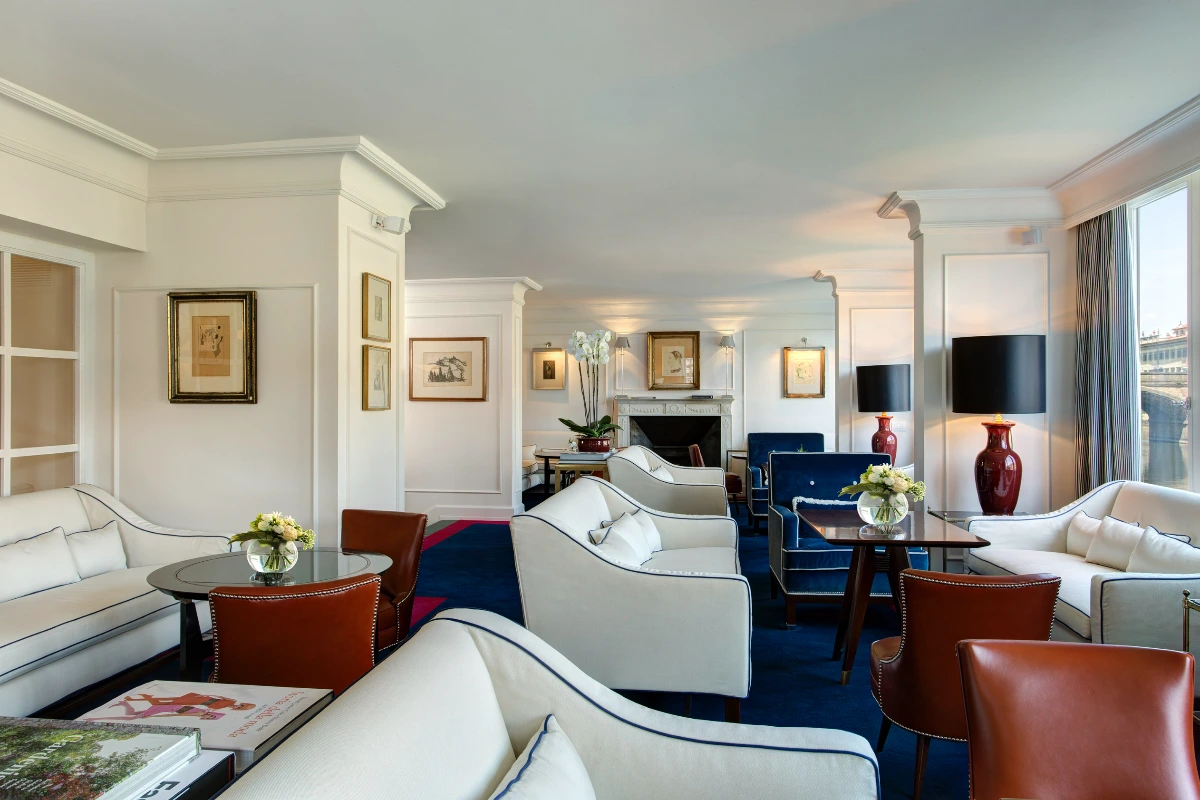
A home away from home: interior design by Michele Bönan
The interior design curated by Michele Bönan is not only an aesthetic statement but also a philosophy of hospitality. The spaces are conceived to evoke the intimacy and warmth of a private residence rather than the formality of a traditional hotel.
Each room and suite is furnished with custom-made pieces that blend classic and contemporary elements. Polished woods, leather upholstery, and nautical-inspired details contribute to a sense of discreet luxury. The concept of nautical luxury – subtle references to the Arno river’s navigational history – is present in chrome details and navy colors, evoking the interiors of a yacht.
Artworks and design elements are distributed in a way that suggests personal collections accumulated over time to convey the idea of a lived-in atmosphere, which challenges the standardization of luxury hotels, proposing a model where elegance and individuality are inseparable.
Public spaces such as the Picteau Lounge and the lobby extend this narrative: intimate, light-filled areas where guests are invited to linger, read, or engage in informal conversations. The objective is to create a continuum between the private and public dimensions of hospitality.

Sustainable hotellerie: preservation of heritage and environmental consciousness
During the major renovation completed in 2017, preservation of the building’s original architectural features was prioritized, while new elements were added to meet contemporary standards of energy efficiency and environmental responsibility.
Materials were sourced locally whenever possible, drawing from Tuscan craftsmanship and limiting transportation emissions. Restoration efforts were conducted with minimal intervention techniques, aimed at conserving historic elements without erasing their patina.
Natural fibers dominate the hotel’s textiles, and energy-saving systems have been implemented for lighting, heating, and water management. Partnerships with regional producers for food and materials also support local economies and reduce environmental footprint.
Staff training programs on sustainability practices are part of an ongoing effort, while future plans include the integration of renewable energy sources and advanced waste reduction systems.
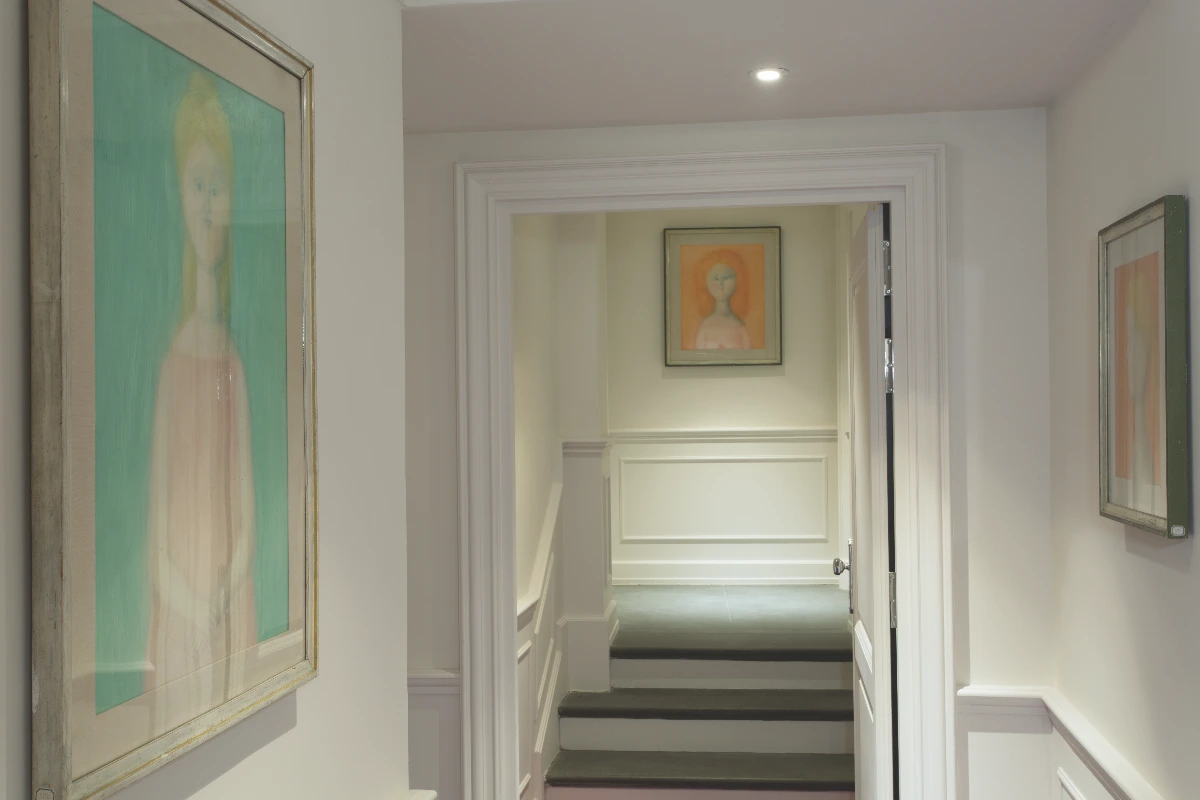
Raw materials: natural elements and the Florentine tradition
The aesthetic philosophy at Hotel Lungarno reflects a broader cultural commitment to artisanal production and Florence’s tradition of craftsmanship. Each material is chosen for its narrative and historical resonance, recalling the ancient workshops of the city where stone, fabric, and wood were shaped into lasting forms.
Natural textures are emphasized throughout: the grain of the wood, the irregular veins of marble, the tactile qualities of linen and cotton textiles. The roughness of certain surfaces is preserved intentionally, highlighting the dialogue between organic imperfection and refined design.
Through this choice, Hotel Lungarno not only pays homage to its geographical and cultural context but also challenges the notion of perfection often associated with luxury hospitality.
Constructing a shared cultural identity through art
By embedding narratives of identity, fragility, and resilience within its walls, Hotel Lungarno does not want to isolate its guests from the world but to immerse them into a broader cultural dialogue.
Artworks by Picasso and Cocteau, among others, serve as portals into universal themes of transformation, identity, and human vulnerability. The hotel thus acts as a platform for cultural reflection, where aesthetic enjoyment is intertwined with ethical and intellectual engagement.
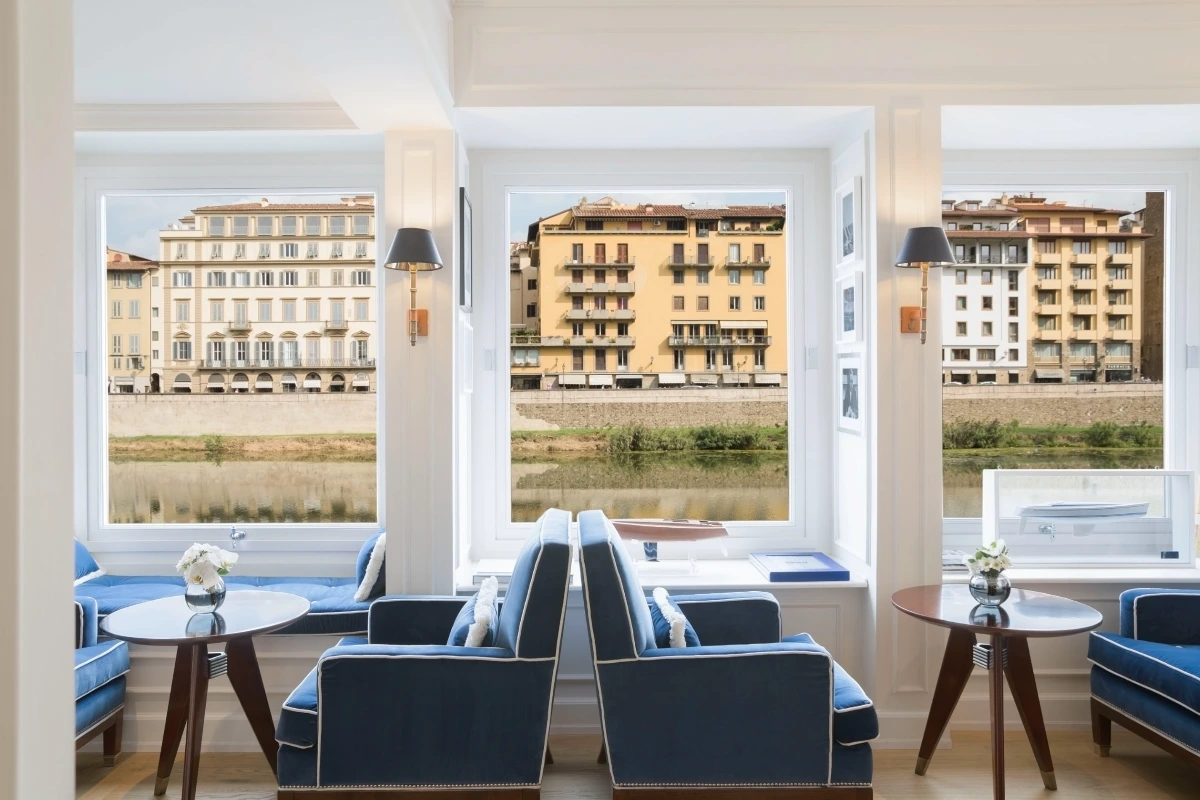
A culinary journey along the Arno
The gastronomic offer at Hotel Lungarno extends the philosophy of sustainability into the culinary field. The Caffè dell’Oro proposes a cuisine based on regional ingredients, interpreted with a contemporary sensitivity. Dishes seek to emphasize simplicity, seasonality, and authenticity, while avoiding unnecessary complication.
Breakfast is conceived as a celebration of Tuscan flavors: local honey, artisan cheeses, freshly baked bread from nearby bakeries, organic fruits from regional producers. Particular attention is given to dietary diversity, with options for plant-based, gluten-free, and health-conscious preferences.
The lounge menu incorporates traditional Florentine snacks revisited with lighter preparations, offering a culinary bridge between heritage and modern lifestyle. Mixology at the Picteau Lounge emphasizes local spirits, artisanal vermouths, and a creative use of botanicals sourced from the Tuscan countryside.
The fashion heritage: Ferragamo’s aesthetic legacy within Hotel Lungarno
The connection to the Ferragamo family introduces an additional cultural layer. Salvatore Ferragamo’s legacy – centered on craftsmanship, innovation, and material excellence – informs Hotel Lungarno’s design vocabulary.
Michele Bönan’s interiors reflect this lineage, using natural materials. Natural leathers, woven textiles, and woods recall Ferragamo’s artisanal approach to shoemaking, translating fashion codes into the language of hospitality.
Fashion photography throughout the hotel, collaborations with emerging designers, and curated capsule exhibitions create a bridge between Florence’s sartorial history and contemporary creative practices. Hotel Lungarno thus becomes not only a place of lodging but also an extension of Florence’s cultural economy, embodying the dialogue between tradition and innovation.
Hotel Lungarno
Hotel Lungarno is a five-star property located along the Arno River in Florence, part of the Lungarno Collection founded by the Ferragamo family. Opened in 1995, the hotel occupies a historic building near Ponte Vecchio and hosts over four hundred and fifty Twentieth-century artworks. Its design combines Florentine craftsmanship, nautical references, and sustainable materials. Hotel Lungarno integrates contemporary hospitality with cultural and artistic heritage.



